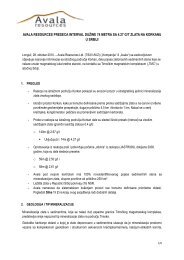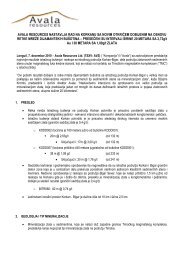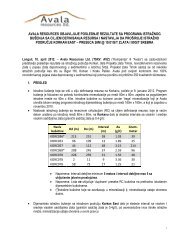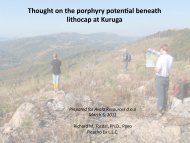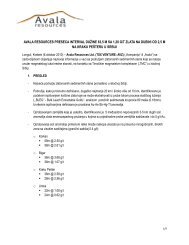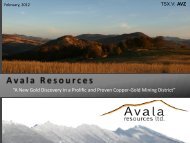Sillitoe, 2010 - Avala Resources Ltd.
Sillitoe, 2010 - Avala Resources Ltd.
Sillitoe, 2010 - Avala Resources Ltd.
Create successful ePaper yourself
Turn your PDF publications into a flip-book with our unique Google optimized e-Paper software.
Thought on the porphyry poten-al beneath<br />
lithocap at Kuruga<br />
Prepared for <strong>Avala</strong> <strong>Resources</strong> d.o.o<br />
March 5, 2011<br />
Richard M. Tosdal, Ph.D., Pgeo<br />
Picacho Ex L.L.C.
KUDD-‐<br />
034<br />
KUDD-‐<br />
005<br />
KUDD-‐<br />
009<br />
Map courtesy of Ivan Strambanovic, <strong>Avala</strong> <strong>Resources</strong>, March 2011<br />
Geology of the northern end of<br />
the Kuruga lithocap, Timok area,<br />
Serbia<br />
Area is underlain by a series of inferred<br />
supracrustal andesi@c volcanic, volcaniclas@c<br />
and tuffaceous rocks<br />
Extensive advanced argillic altera@on has<br />
converted much of the high topography to a<br />
silica±alunite±pyrophyllite lithocap.<br />
Significant hydrothermal breccia is present<br />
and the surface and in the historical drilling.<br />
3 drill holes were examined; KUDD-‐005 and<br />
KUDD-‐009 were drilled on the north into the<br />
mineralized part of a breccia complex;<br />
KUDD-‐034 explored the poten@al for a deep<br />
porphyry Cu system on the SW corner of the<br />
area.
<strong>Sillitoe</strong>, <strong>2010</strong><br />
What is seen in the Kuruga deep drill hole<br />
(KUDD-‐034)?<br />
Quartz – pyrophyllite?-‐kaolinite (supergene)<br />
at 33m<br />
Serici@zed gusano textured<br />
qtz-‐pyrophyrllite rock @ 57m
<strong>Sillitoe</strong>, <strong>2010</strong><br />
Sericite-‐chlorite overprint on 2nd Kuruga KUDD-‐034<br />
bio@te @213m<br />
Sericite-‐chlorite overprint on pervasive 2 nd<br />
bio@te-‐magne@te @285m
<strong>Sillitoe</strong>, <strong>2010</strong><br />
Kuruga KUDD-‐034<br />
Chlorite-‐sericite pyrite overprint<br />
on 2 nd bio@te-‐magne@te @288 m<br />
Anhydrite-‐pyrite vein with bleached<br />
chlorite-‐bearing selvage @330m
<strong>Sillitoe</strong>, <strong>2010</strong><br />
Kuruga KUDD-‐034<br />
Groundmass feldspar overprinted by<br />
anhydrite-‐pyrite-‐chlorite @428m<br />
Transi@on from pervasive 2 nd bio@te-‐magne@te to “unaltered” host<br />
hornblende diorite over 5 cm @460m
<strong>Sillitoe</strong>, <strong>2010</strong><br />
KUDD-‐034<br />
What part of a porphyry system might the deep<br />
Kuruga drill hole KUDD-‐034 have encountered?<br />
From top to ~462 m depth, the drill hole passed through rocks showing<br />
the typical hydrothermal silicate altera@on assemblage characteris@c of<br />
a porphyry Cu hydrothermal system.<br />
However, there was a remarkable lack of quartz veins as well as Cu-‐Fe<br />
sulfide minerals. The overall grade is likely low, perhaps in the 0.1+% Cu<br />
from the serici@c zone through the K silicate (potassic) altera@on zone.<br />
Pyrite where present is replacing Fe-‐bearing minerals (2 nd bio@te and<br />
magne@te) that form a pervasive replacement of mafic phases as well<br />
as veins<br />
Pyrite is also associated with anhydrite.<br />
The transi@on in the drill core from intensely altered to almost<br />
unaltered is very sharp (over 5 cm); sharp lateral gradients are expected<br />
as hydrothermal fluid flow on the margins will be largely ver@cal and in<br />
the case of the drill hole based on grain boundary diffusion due to the<br />
lack of significant veins.<br />
Taking all the observa@ons suggests that the drill hole KUDD-‐034 may<br />
have just cut the pervasive altera@on that extend outside the Cu shell<br />
(dashed line on cartoon to lej).
KUDD-‐034<br />
Loca-on of KUDD-‐034 with<br />
respect to soil Mo geochemistry<br />
Molybdenum forms a low grade shell (9 ppm<br />
Drill hole was collared at the southern end<br />
of the area of anomalous Mo and<br />
oriented easterly (shown approximately in<br />
pale green).<br />
Collec@vely, the soil geochemistry and the<br />
rocks in the drill hole suggest that the<br />
main por@on of a poten@ally mineralized<br />
porphyry may lie to the north of the<br />
KUDD-‐034.<br />
Map provided by Ivan Strambanovic,<br />
<strong>Avala</strong> <strong>Resources</strong>, 2011
Anatomy of a hydrothermal<br />
breccia<br />
In general, hydrothermal breccia show systema@c facies.<br />
There is a core of highly brecciated material. Where<br />
fluidiza@on has been intense, the matrix consists of rock flour<br />
(finely milled rock) with clasts of varying sizes. In a single<br />
stage breccia, clast sizes increase in size and angularity<br />
toward the margin. Rocks immediately outside of the breccia<br />
are crackled, that is fractured in place and essen@ally can be<br />
fit together as a jig-‐saw. Inter-‐clast displacement and<br />
rounding increases toward the breccia.<br />
Mul@-‐stage breccia have complex overprin@ng facies from the<br />
subsequent events.<br />
Breccia nucleate at depth and propagate upward un@l the<br />
energy is dissipated, thereby forming conical body. The roof<br />
rocks are cut by fingers of crackle breccia to rock flour breccia<br />
which represent the upward propaga@on of the larger body.<br />
Areas of maximum permeability are along breccia margins;<br />
complex when mul@ple breccia bodies present.<br />
Where they breach the surface, they form dis@nc@ve<br />
volcanic-‐like features (see next slide)
Anatomy of a hydrothermal breccia that vented to the surface<br />
Hydrothermal breccias that breach the<br />
surface some@mes are called diatremes.<br />
However that term is largely reserved to<br />
breccias formed from magma@c or<br />
phreato-‐magma@c processes whereby<br />
magma expands catastrophically to<br />
excavate a conical crater. In hydrothermal<br />
and magma@c-‐related breccias, the<br />
excavate cone is filled with material that<br />
was not ejected and that falls back into the<br />
crater.<br />
Breccia facies are similar to those in<br />
hydrothermal breccias but in magma@c<br />
breccias there is juvenile material in the<br />
form of irregular ameboidal shaped clasts.<br />
Permeability will be greatest along the<br />
breccia margins, or where mul@ple<br />
breccia@on events are superposed.<br />
The cri@cal criteria required to dis@nguish<br />
interac@on with magma is the presence of<br />
the juvenile clasts.
KUDD-‐009<br />
KUDD-‐<br />
005<br />
Kuruga breccia facies placed in<br />
context of simple hydrothermal<br />
breccia<br />
Clas@c rock with 0.5 ppm Au; KUDD-‐009<br />
Tuffaceous horizon @32m; KUDD-‐009
KUDD-‐009<br />
KUDD-‐<br />
005<br />
Auriferous crackle brecca forming feeder to<br />
overlying porous sediments; KUDD-‐009<br />
Low Au grade cap over rock flour matrix<br />
breccia; KUDD-‐009 @155 m
KUDD-‐009<br />
KUDD-‐<br />
005<br />
Marginal crackle breccia; KUDD-‐005<br />
@ 23m with 1.93 ppm Au<br />
Alunite cemented rock flour<br />
breccia; KUDD-‐005 @ 195m
KUDD-‐009<br />
KUDD-‐<br />
005<br />
Pyprite-‐enargite cemente breccia margin;<br />
KUDD-‐005 @ 70 m<br />
Mul@ple rebreccia@on with pyrite<br />
±enargite replacement of youngest rock<br />
flour; KUDD-‐005 @ 225 m
KUDD-‐009<br />
KUDD-‐<br />
005<br />
Host Rocks to breccia<br />
Gusano (worm) texture in host<br />
rock — appears to be similar<br />
to many of the siliceous clasts<br />
in the hydrothermal breccia<br />
Relict igneous texture in rare clast<br />
sugges@ng breccia cuts plagioclase and<br />
hornblende phyric rocks at depth
What type of breccia underlies the northern part of the Kuruga<br />
property?<br />
Insufficient knowledge is available regarding the original style of breccia that forms the northern<br />
part of Kuruga. Drill hole KUDD-‐009 appears to have drilled into the top of a breccia body,<br />
whereas KUDD-‐005 was collared within a breccia margin. The laqer drill hole was collared at<br />
higher eleva@ons, and shows evidence of mul@stage breccia@on. An important observa@on is<br />
that the dominant clast in the breccia is silicified rocks, and thus essen@ally country rocks.<br />
Hence, trea@ng the breccia as a series of nested largely hydrothermal breccia lacking obvious<br />
magma@c input seems to be the most reasonable model at this date.<br />
Recognizing the mul@stage<br />
evolu@on of the breccia<br />
poten@ally is important,<br />
and should be clarified as it<br />
may play a role in<br />
mineraliza@on.
Some concluding thoughts<br />
1. Clearly there is evidence for considerable hydrothermal ac@vity at Kuruga. There is a deep porphyry<br />
evident as well as extensive hydrothermal breccia present.<br />
2. Gold in the lithocap is stratabound within a permeable tuffaceous horizon as well as within the<br />
crackle and jigsaw margins of the breccia.<br />
3. Copper in the lithocap is associated with a second (or third?) stage of breccia@on and is associated<br />
with enargite-‐pyrite cement.<br />
4. No evidence has been seen to date to indicate that the breccias have a magma@c component. If<br />
this is true, then they represent the catastrophic volume expansion of the hydrothermal fluid. If<br />
this is true, there is no need for them to be located over the top of a porphyry-‐style intrusion.<br />
Instead, they can be lateral to the intrusive center.<br />
5. The evidence for intense and pervasive K-‐silicate altera@on in the deep drill demands a porphyry<br />
center at depth, as would be expected. What is not know is whether it is mineralized as well. A drill<br />
hole into the main part of the likely porphyry is warranted.<br />
6. Judging from the depth of sulfide in drill core and in the nearby Lipa system, the sulfide in the<br />
porphyry center is likely to begin around depths of 650 m RL, and extend to depth. This depth<br />
approximately corresponds to the depth of extensive and not overprinted K silicate altera@on in<br />
KUDD-‐034.




